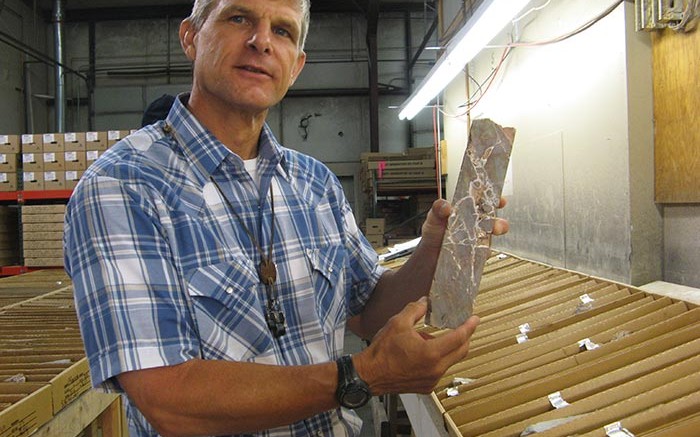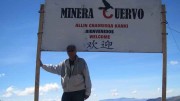ELKO, NEVADA — Gold Standard Ventures’ (TSXV: GSV; NYSE-MKT: GSV) Railroad project is at the southern end of Nevada’s famous Carlin trend, but co-founder Luke Norman likes to first take visitors to a lookout at the northern end, where a cluster of Newmont Mining (NYSE: NEM) and Barrick Gold’s (TSX: ABX; NYSE: ABX) mining facilities dot the hilly landscape.
“Look at how few trucks there are,” Norman says, who is a junior mining financier.
With near-surface resources dwindling after decades of mining the Carlin, operations here are moving underground.
“You’ve got massive depletion occurring in this part of the world and it’s not being replaced by discovery,” Norman says. “It’s not being replaced anywhere globally by discovery.”
Gold Standard, which has amassed the second-largest land package on the Carlin trend — after Newmont Mining — is doing its best to fill the discovery gap.
The journey hasn’t been easy.
Gold Standard’s founders Norman and president and CEO Jonathan Awde have spent years and completed hundreds of land deals to consolidate the junior’s 115 sq. km Railroad land package at the southern end of the Carlin trend — a prospective area that has been underexplored because of fragmented ownership, going back decades.
They also put together a top-notch team of senior Nevada orefinders who have made discoveries in the Carlin, and elsewhere in north-central Nevada.
After listing in 2010, Gold Standard spent a year or so in the spotlight after finding North Bullion in 2011, which delivered a series of long, high-grade drill intercepts in 2012, including 56.4 metres at 4.26 grams gold per tonne and 164 metres of 3.38 grams gold.
However, interest in exploration has dried up since then.
And North Bullion, a classic Carlin-type deposit with complex geology and deeper, refractory gold (mineralization starts around 100 metres deep) will take time and money to assess.
In response to an impatient and largely indifferent market for gold exploration, Gold Standard has turned its attention to near-surface oxide deposits at Railroad, such as its recently acquired Pinion project.
And with the financial support of a new investor — OceanaGold (TSX: OGC; ASX: OGC) invested $16.2 million in return for a 14.9% stake in the junior in May — Gold Standard is working on an updated resource for the project, which could lead to a preliminary economic assessment.
Awde acknowledges that interest in exploration is near non-existent, but says that the best projects will find a market.
“There’s obviously an argument to do nothing — just sitting on the cash and riding this market out,” Awde says in an interview from his Vancouver office. “But I think if you’re an exploration company and you’re not exploring, what’s the point? We felt quite strongly that we were not going to be that kind of a company. We’re an exploration company, and we wanted to make our mark doing so.”
With the OceanaGold financing, Gold Standard has insurance against a prolonged downturn, Awde says, adding that the company could avoid financing for another two to three years in a worst-case scenario.
A gold producer with mines in the Philippines and New Zealand that also made a friendly bid for Romarco Minerals (TSX: R) for its Haile gold mine in South Carolina, OceanaGold bought 25 million common shares at 65¢ apiece. It also has the option to increase its interest to just under 20% this year, four months after the initial financing.
“We thought it would be great to shore up our balance sheet and potentially act as a buffer in event that the market got worse — which it has — and it would really validate the work we’ve done at Railroad and Pinion,” Awde says of the deal.
“We really liked the direction that Oceana was going and the teams get along well,” Awde adds. “We’re not sure how long this downturn will take to work itself out, but we think that being one of the few cashed up juniors in the sector and actually get work done, and capitalize on lower costs across the board — we felt it was a good buffer and a bit of a security blanket.”
Pinion
Gold Standard acquired the historic Pinion oxide gold deposit, less than 15 km south of North Bullion on the Carlin trend, over two stages in 2013 and 2014.
Last year the junior released a National Instrument 43-101-compliant resource for the deposit, doubling historic resources. Pinion now holds 20.8 million indicated tonnes grading 0.63 gram gold per tonne for 423,000 oz. and 55.9 million inferred tonnes grading 0.57 gram for 1 million oz., using a cut-off grade of 0.14 gram gold per tonne.
While its grade may not seem exciting, the company sees Pinion as a potentially low-cost development option that will have value in any market.
“It’s pretty low grade, but it’s similar to Emigrant, which is Newmont’s lowest-cost producing pit in Nevada,” vice-president of exploration Mac Jackson said in an interview at Gold Standard’s office in Elko. “The cut-off is 0.14 gram gold, so Newmont is producing at Emigrant at the same levels and cut-offs.”
A collapse-breccia deposit, Pinion mineralization is extensive, well-behaved and consistent, Jackson says. The oxidized zone so far extends 2.5 km northwest to southeast, and is 1 to 1.5 km wide.
In addition to the Pinion resource, Gold Standard released an initial inferred resource in March for its Dark Star deposit, another near-surface, oxide deposit just 2.1 km east of Pinion. Based on 105 historic reverse-circulation (RC) drill holes, Dark Star holds inferred resources of 23.1 million tonnes grading 0.51 gram gold for 375,000 oz. gold at the same cut-off grade as Pinion.
Drill hole 15-3, which hit sulphides southeast of the Pinion resource, has also revealed that the company could be close to a high-grade feeder structure.
Current work
With the market for gold exploration at such a low ebb, Awde plans to use Gold Standard’s treasury — $17 million in working capital at the end of June — very carefully.
“We’re conducting smaller, methodical, strategic programs designed to add shallow oxide at Pinion, potentially tagging into some deeper higher grade, getting metallurgy done — things we feel quite strongly that in a more rational market will add value,” he says.
To grow both deposits, Gold Standard finished a 14-hole, 4,900-metre RC drill program earlier this year (nine holes at Pinion, five at Dark Star). In August it began a second-phase program for up to 27 RC holes to expand shallow resources and test new targets. Pinion could see 10 holes (3,950 metres), with up to 13 holes (3,700 metres) drilled at Dark Star.
Some of the holes have found grades higher than 1 gram gold per tonne, including a 24.4-metre interval of 1.38 grams gold in hole 15-02 at Pinion.
By late 2015, or the first quarter of 2016, the company aims to update resources for both deposits, and have the results of metallurgical testing.
If the metallurgy results are positive, it will begin a preliminary economic assessment that builds on engineering, metallurgical and environmental work.
Preliminary metallurgical work has been promising. In August, Gold Standard announced that Pin
ion samples are cyanide soluble from the multilithic dissolution collapse breccia — the main gold host at the deposit — and from oxidized zones outside the main host. Gold recoveries from the samples averaged 82.4%, indicating the deposit would be amenable to heap leaching.
Despite the focus on Pinion and Dark Star, and oxide targets close to the two deposits, there is so much potential at Railroad that a company without a disciplined management team could find it overwhelming.
The company found North Bullion, a blind target, by looking for fault structures and anomalous results from soil sampling (with arsenic, antimony and barite). It was drilled ahead of other targets simply because it was more accessible.
“We drilled North Bullion because the road that came into Railroad drives straight to where North Bullion is,” Norman says. “We had a limited amount of resources in terms of cash, so we drilled our first target, and lo and behold, we hit a massive gold system.”
The company says there is more gold to be found at Railroad, as well as polymetallic deposits (the Central Bullion area at Railroad hosted a historic mining district) and copper-gold potential (drilling at the Bald Mountain oxide copper-gold target returned 56 metres of 1.47 grams gold in oxides, followed by 23 metres of 0.4% copper in 2013).
In the meantime, the mining downturn could give Gold Standard a chance to go back to North Bullion to put together an initial resource. Awde says the company is awaiting quotes on a six-hole stepout drilling program at North Bullion. In 2012, some of the deeper holes cost north of $300,000 apiece. The company is looking for a 40% price reduction before it commits to a program — which is a realistic target, given that drilling costs at Pinion have come down 20–25% year over year.
Investors
In addition to OceanaGold, Gold Standard has attracted a sizable list of patient investors, with 50% of its shares owned by institutional investors. Albert Friedberg’s FCMI Financial owns 20% of the company. More recent investors include ex-Cayden Resources CEO Ivan Bebek, who came on as a special advisor in February, and the Hunt family of oil tycoons out of Texas (known for their play on the silver market in the 1980s). Management and insiders own 13%.
Awde sees the company’s large shareholders as both protection against any hostile takeover attempts and a reflection of its quality.
“It’s been a really strong group that’s come in here, and a lot of them are new,” Awde says. “I think it’s a testament to the asset, the jurisdiction and the people involved in the deal.”
Gold Standard shares recently traded at 45.5¢ in a 52-week window of 40–80¢. The company has 167.8 million shares outstanding.






Be the first to comment on "Site visit: Gold Standard makes its mark in Nevada"